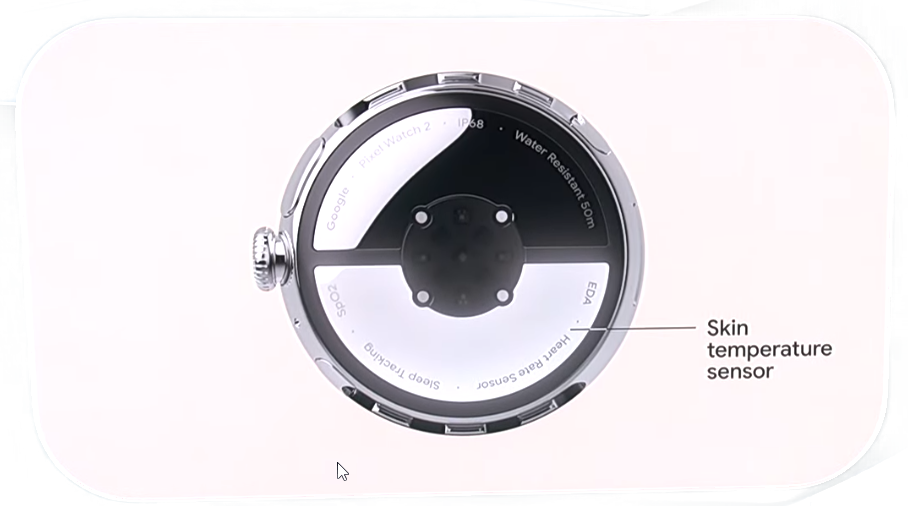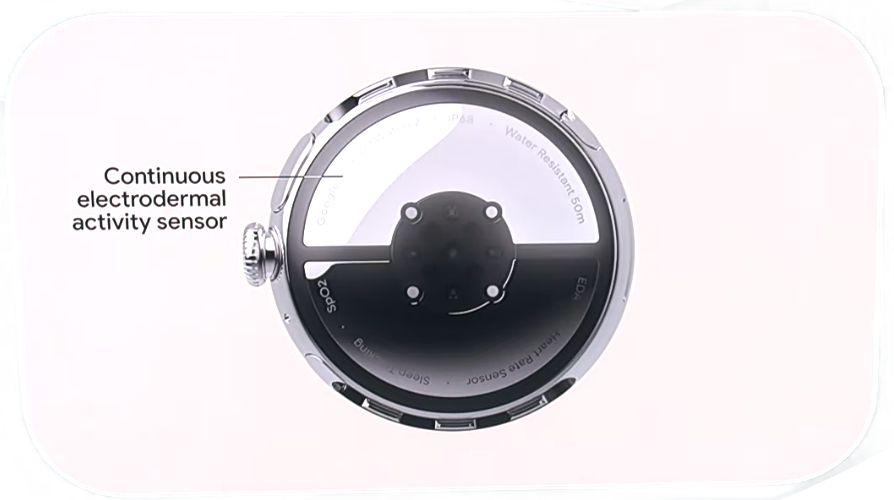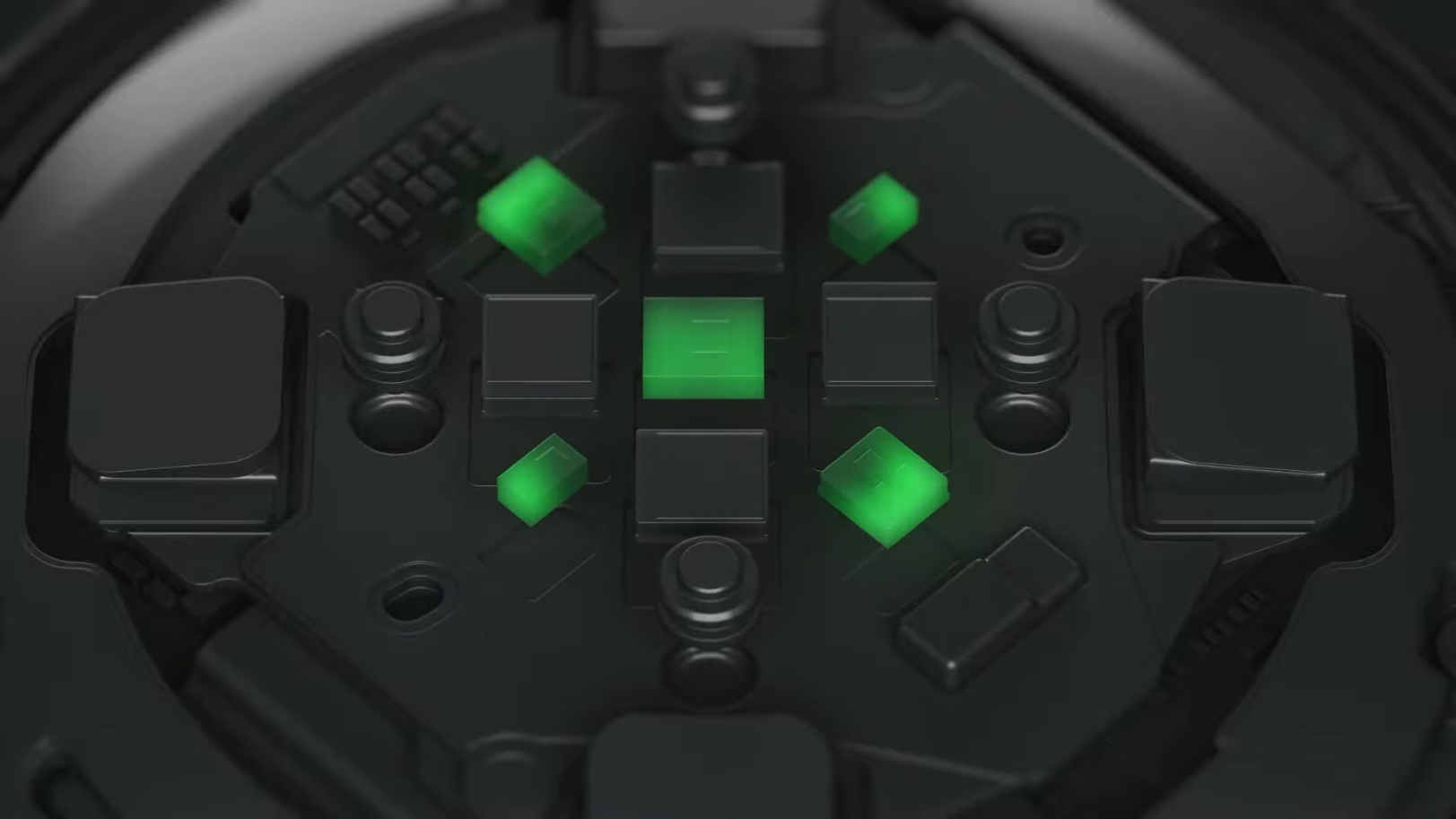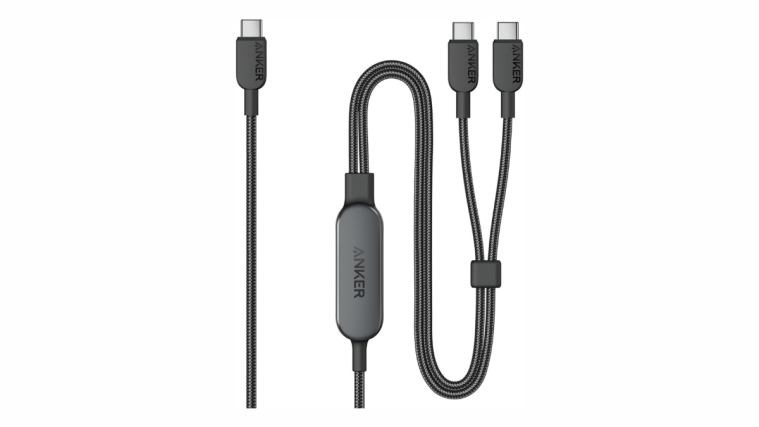What to know
- The Google Pixel Watch 2 is equipped with two innovative sensors: a skin temperature sensor and the cEDA, or Continuous Electrodermal Activity sensor.
- The skin temperature sensor monitors your body temperature, logging shifts over time to provide greater insight into your overall health. The cEDA sensor tracks your electrodermal activity, looking for potential signs of stress.
- Whenever these sensors record any significant changes, you’ll be notified. To understand more about these features and how they can assist in managing your health, refer to the detailed post below.
The 2023 Made by Google event showed lots of new tech. The main showcases were the Google Pixel 8 and 8 Pro smartphones, along with the updated Google Pixel Watch 2. Well, kind of built upon its very foundations from the original watch, the Pixel Watch 2 boasts new construction materials, a better CPU, and, impressively, a suite of innovative sensors — yes, that got us excited, too!
If you keep up with tech news, you may know about the two new sensors in the Pixel Watch 2. But what are they exactly, and how do they make your daily life better? Let’s look into these new features.
What are the two new sensors on the Google Pixel Watch 2?
The Pixel Watch 2 comes with two new sensors, the temperature sensor and the cEDA or the Continuous Electrodermal activity sensor. The heart rate sensor has also been revamped for better accuracy and faster reading times. Let’s take an in-depth look at each of these sensors and how they work in the new Pixel Watch 2.
1. The temperature sensor

The Pixel Watch 2 now comes with a skin temperature sensor that measures the temperature of your skin over time and alerts you about any discrepancies or drastic changes. This can help offer better insight into your overall health, especially when you’re sleeping at night. The Pixel Watch 2 at the bottom has been divided into two halves, and one half is dedicated to the skin temperature sensor.
Remember that Google denotes that the temperature sensor won’t be available in all regions of the world. Additionally, the new skin temperature sensor won’t be as accurate in regions with high ambient temperatures or locations where the temperature drastically changes over the course of a day.
2. The stress sensor (Continuos Electrodermal activity sensor)

As discussed above, the bottom of the Pixel Watch 2 has been divided into two halves. While the first half is dedicated to the skin temperature sensor, the second half is dedicated to the cEDA or the Continuos Electrodermal activity sensor. This sensor allows the Pixel Watch 2 to record and log your body response tracking, which can be used to determine whenever you’re going through stressful situations.
If that happens to be the case, then you can be prompted to log your mood, practice mindfulness activities like breathing, and more. This data regarding your general stress levels over the week is constantly regarded, and you are presented with a graphical report for the same at the end of the week. So, if you have been finding it hard to manage your stress or gauge stressful situations in your life, then the new cEDA sensor on the Pixel Watch 2 can definitely help you in this regard.
What’s new in the heart sensor?

Heart rate sensors aren’t new in smartwatches, however, Google has revamped the existing heart rate sensor from the Pixel Watch 1. The Pixel Watch 1 featured a single path sensor, which required your watch to be in a specific location on your wrist to measure your heart rate accurately.
This has changed as the Pixel Watch 2 comes bundled with a new multi-path heart rate sensor. It has 10x more optical channels to accurately measure your heart rate no matter how you wear your Pixel Watch 2. In addition, Google has also improved its ML or machine learning algorithm, which results in up to 40% improvement in heart rate tracking accuracy.
How can the stress and temperature sensors help you?
The skin temperature sensor can help you monitor your overall temperature for a few weeks to look for any discrepancies that might be a symptom of an underlying health condition. It can also help you understand when your body goes through temperature shocks, random chills, and more and if it is related to a health condition.
On the other hand, the cEDA sensor or the Continuos Electrodermal activity sensor is designed to help you better manage your stress. This sensor can detect your epidermal electric activity and gauge when you’re going through periods of stress. The sensor can then trigger the Pixel Watch 2 to intervene and suggest mindful activities that can help you better manage your stress. These include breathing exercises, interventions, and other third-party tools from apps you might have installed.
We hope this post helped you learn more about the new sensors in Google Pixel Watch 2 and how you can use them to your advantage. If you have any more questions for us, feel free to reach out using the comments section below.
What to know
- The Google Pixel Watch 2 is equipped with two innovative sensors: a skin temperature sensor and the cEDA, or Continuous Electrodermal Activity sensor.
- The skin temperature sensor monitors your body temperature, logging shifts over time to provide greater insight into your overall health. The cEDA sensor tracks your electrodermal activity, looking for potential signs of stress.
- Whenever these sensors record any significant changes, you’ll be notified. To understand more about these features and how they can assist in managing your health, refer to the detailed post below.
The 2023 Made by Google event showed lots of new tech. The main showcases were the Google Pixel 8 and 8 Pro smartphones, along with the updated Google Pixel Watch 2. Well, kind of built upon its very foundations from the original watch, the Pixel Watch 2 boasts new construction materials, a better CPU, and, impressively, a suite of innovative sensors — yes, that got us excited, too!
If you keep up with tech news, you may know about the two new sensors in the Pixel Watch 2. But what are they exactly, and how do they make your daily life better? Let’s look into these new features.
What are the two new sensors on the Google Pixel Watch 2?
The Pixel Watch 2 comes with two new sensors, the temperature sensor and the cEDA or the Continuous Electrodermal activity sensor. The heart rate sensor has also been revamped for better accuracy and faster reading times. Let’s take an in-depth look at each of these sensors and how they work in the new Pixel Watch 2.
1. The temperature sensor

The Pixel Watch 2 now comes with a skin temperature sensor that measures the temperature of your skin over time and alerts you about any discrepancies or drastic changes. This can help offer better insight into your overall health, especially when you’re sleeping at night. The Pixel Watch 2 at the bottom has been divided into two halves, and one half is dedicated to the skin temperature sensor.
Remember that Google denotes that the temperature sensor won’t be available in all regions of the world. Additionally, the new skin temperature sensor won’t be as accurate in regions with high ambient temperatures or locations where the temperature drastically changes over the course of a day.
2. The stress sensor (Continuos Electrodermal activity sensor)

As discussed above, the bottom of the Pixel Watch 2 has been divided into two halves. While the first half is dedicated to the skin temperature sensor, the second half is dedicated to the cEDA or the Continuos Electrodermal activity sensor. This sensor allows the Pixel Watch 2 to record and log your body response tracking, which can be used to determine whenever you’re going through stressful situations.
If that happens to be the case, then you can be prompted to log your mood, practice mindfulness activities like breathing, and more. This data regarding your general stress levels over the week is constantly regarded, and you are presented with a graphical report for the same at the end of the week. So, if you have been finding it hard to manage your stress or gauge stressful situations in your life, then the new cEDA sensor on the Pixel Watch 2 can definitely help you in this regard.
What’s new in the heart sensor?

Heart rate sensors aren’t new in smartwatches, however, Google has revamped the existing heart rate sensor from the Pixel Watch 1. The Pixel Watch 1 featured a single path sensor, which required your watch to be in a specific location on your wrist to measure your heart rate accurately.
This has changed as the Pixel Watch 2 comes bundled with a new multi-path heart rate sensor. It has 10x more optical channels to accurately measure your heart rate no matter how you wear your Pixel Watch 2. In addition, Google has also improved its ML or machine learning algorithm, which results in up to 40% improvement in heart rate tracking accuracy.
How can the stress and temperature sensors help you?
The skin temperature sensor can help you monitor your overall temperature over a few weeks to look for any discrepancies that might be a symptom of an underlying health condition. It can also help you understand when your body goes through temperature shocks, random chills, and more and if it is related to a health condition.
On the other hand, the cEDA sensor or the Continuos Electrodermal activity sensor is designed to help you better manage your stress. This sensor can detect your epidermal electric activity and gauge when you’re going through periods of stress. The sensor can then trigger the Pixel Watch 2 to intervene and suggest mindful activities to help you better manage your stress. These include breathing exercises, interventions, and other third-party tools from apps you might have installed.





